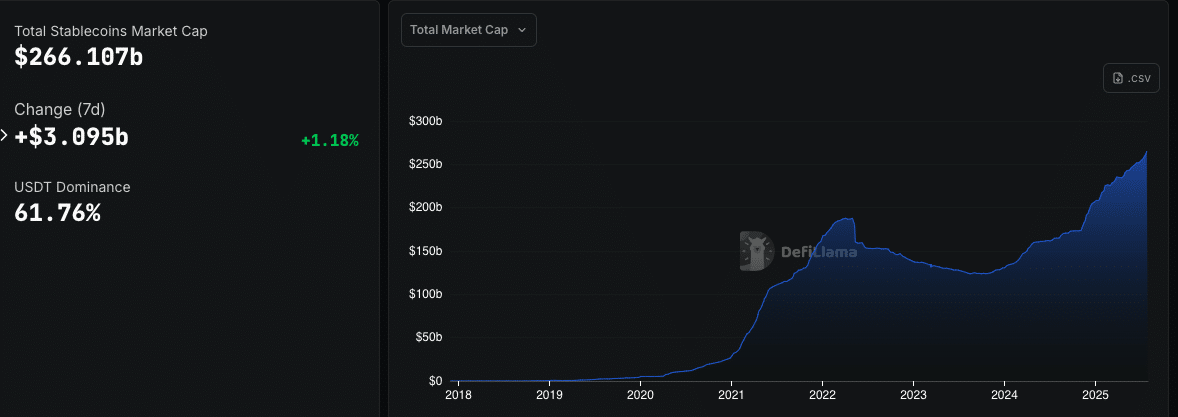Following the latest industry reports, BlackRock Investment Institute has said in its latest commentary that the new GENIUS Act puts stablecoins in the “future of finance”, remodelling them into regulated payment tools rather than speculative investments. The firm said the new federal rulebook brings clarity towards mainstream adoption. According to them, ‘Stablecoins look here to stay’.
- GENIUS Act Turns Stablecoins Into Legal Payment Rail
- $250B Market Rooted in Institutional Reality
- Global Competition: U.S. vs. Europe and Hong Kong in Stablecoin Race
- Hybrid Monetary System
- Conclusion
- FAQs
- Are stablecoins now considered payment instruments under U.S. law?
- What backing requirements are imposed on stablecoin issuers?
- Does the Act allow interest payments on stablecoin balances?
- What is the size of the stablecoin market today?
- How does the U.S. compare globally on stablecoin regulation?
- Glossary
GENIUS Act Turns Stablecoins Into Legal Payment Rail
Signed into law on July 18, 2025, the GENIUS Act is a legislation that legally reclassifies payment stablecoins as usable tools, not commodities or securities. Issuers must hold full reserve backing using U.S. Treasury bills, cash, or short-term repos, submit to bank-level audits, and comply with anti-money-laundering regulations. Interest prohibition on balances shows the law is all about transactional use.
BlackRock said this clarity allows banks and approved non-bank issuers to deploy tokenized dollar networks for cross-border payment, making stablecoins the foundation of digital settlement rails.
$250B Market Rooted in Institutional Reality
Stablecoins have grown to $266B in market cap, about 7% of the overall crypto market; BlackRock noted in its recent report. Circling major issuers like Tether and Circle which have over $120B in U.S. Treasury reserves, the law reinforces stable adoption without destabilizing Treasury yields.

The reserve stability requirements are designed to mitigate systemic risk while reinforcing the dollar’s liquidity infrastructure. BlackRock expects minimal impact on bill yields because stablecoin related capital is rotating from similar short-term asset classes.
Global Competition: U.S. vs. Europe and Hong Kong in Stablecoin Race
BlackRock puts the U.S. regulatory move in global context, noting Hong Kong and Europe’s competing strategies. Europe’s MiCA framework and Hong Kong’s pro-stablecoin stance are vying for institutional advantage, while the U.S. is focused on consumer protection and banking guardrails.
The difference between jurisdictions; like whether interest can be paid on stablecoin holdings; will determine if dollar-backed digital currency becomes the dominant currency in cross-border trade finance.
According to KPMG and McKinsey reports, the GENIUS Act is triggering a digital finance revolution. Providers are scaling tokenized money market funds, real-time settlement rails and fractional collateral systems, all now backed by a stable legal framework.
BlackRock’s report sees these regulatory changes as one of several megatrends driving returns and transforming institutional portfolios.
Hybrid Monetary System
Academic research suggests a future where private stablecoins and fiat coexist. The rise of hybrid monetary systems means programmatic efficiency and liquidity resilience. As BlackRock said, stablecoins could be “programmable money” layers on top of cash, enabling real-time cross-border value transfer.

Despite the optimism, there are concerns. Analysts warn that banning interest on stablecoins may reduce adoption in deposit-rich economies. Regulators also caution about depegging risks, institutional concentration, and Treasury market disruption if redemptions surge during stress.
Conclusion
Based on the latest research, BlackRock’s commentary tags stablecoins as the future of finance, as they are now legally recognized as digital rails for payments, as opposed to speculative tokens, all because of the GENIUS Act. Regulatory clarity has put stablecoins at the intersection of payments, treasury operations and cross-border finance.
Challenges remain especially around interest, issuer concentration, and market stability, but the U.S. is in the race for digital monetary leadership.
For in-depth analysis and the latest trends in the crypto space, our team offers expert content regularly.
Summary
BlackRock Investment Institute says under the GENIUS Act, stablecoins have moved from speculative assets to the future of finance as regulated, dollar-backed payment instruments. With reserve requirements, audit mandates and issuance limits in place, the law gives U.S. financial institutions a legal way to deploy token-based payment systems.
FAQs
Are stablecoins now considered payment instruments under U.S. law?
Yes, the GENIUS Act officially classifies compliant stablecoins as legal payment methods, not securities or commodities.
What backing requirements are imposed on stablecoin issuers?
Issuers must hold 1:1 collateral in cash, Treasury bills or repos that mature within 93 days, plus independent audits and AML compliance.
Does the Act allow interest payments on stablecoin balances?
No, the Act prohibits interest accrual on stablecoin holdings to prevent use as cash substitutes.
What is the size of the stablecoin market today?
Stablecoins are about 7% of total crypto market value, with a market cap of $250 billion.
How does the U.S. compare globally on stablecoin regulation?
The U.S. regulates via the GENIUS Act, while regions like Europe and Hong Kong are exploring digital euro frameworks and more permissive issuer models, so competition is heating up.
Glossary
Future of finance stablecoins – BlackRock’s term for stablecoin adoption as payment infrastructure.
GENIUS Act – U.S. federal law signed July 18, 2025, for the first payment stablecoin regulation.
Payment Stablecoin – Digital tokens backed by fiat and approved for use as payment settlement instruments.
Reserve backing – Issuers must hold cash, Treasury bills or repos that mature within 93 days.
Depegging risk – Stablecoin value can diverge from fiat peg in crisis or redemption.



















































































































